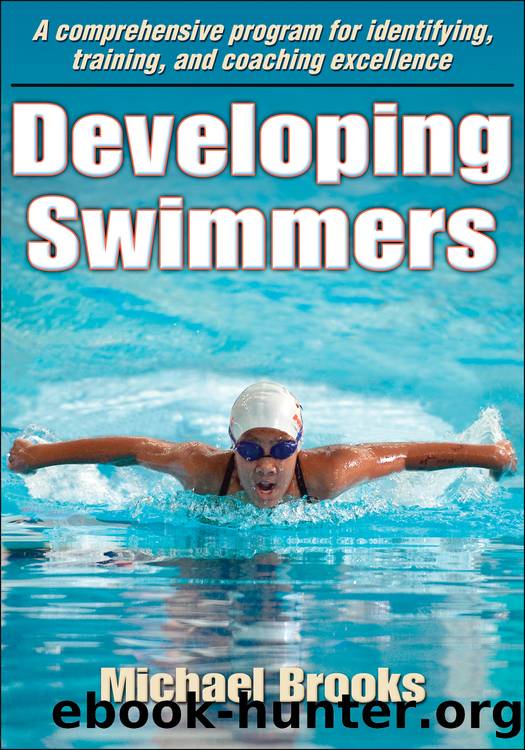Developing Swimmers by Michael Brooks

Author:Michael Brooks
Language: eng
Format: epub
Publisher: Human Kinetics, Inc.
FIGURE 7.19â â â â An undulating breaststroker with an overlap between kick and pull.
Age-Group Breaststroke Training
The biggest difference between fast and slow breaststrokers is the strength of the kick. Good breaststrokers can get their legs and feet into positions of biomechanical strength and efficiency whereas poor breaststrokers cannot. The latter may work hard, but they are pushing less water and pushing it in the wrong directions. In individual medleyâbased programs, every swimmer participates in individual medley, and a poor breaststroke can sink the ship. Thus, age-group coaches canât simply ignore this problem as a senior coach can, in theory at least, when working with an older national-level flyer who canât breaststroke.
Swimmers need fit legs and effective kicks. Breaststroke kicking for man-made breaststrokers is crucial to their development. Coaches must develop the flexibilities and ranges of motion early. To that end, we incorporate a special breaststroke leg stretching routine into our dryland training several times a week (see chapter 9). Further, we do more kicking and kicking-oriented drills with breaststroke than with the other strokes.
As with butterfly training, we use only a few stroke drills, and we use them advisedly. Here the difference between an elite swimmer and an age-grouper is important in determining the content of the training program. An elite senior breaststroker may spend a large percentage of her everyday training swimming breaststroke. For that reason, a myriad of drills might be necessary to vary the stresses and to keep the swimmerâs stroke, timing, and attitude fresh. But if we coach young swimmers who train breaststroke only a couple of times each week, we cannot do 15 pulling-oriented drills and 15 kicking-oriented drills if we want to get anything accomplished. We need less French pastry, more meat and potatoes.
However, we use a few drills from time to time. Stroke drills may be a part of a training program, but they cannot substitute for swimming the full stroke fast and with good technique. Using drills occasionally must help coaches and swimmers attain this goal and not become a diversion that gets in the way of the goal. The following drills emphasize body position, perfect technique, power, and proper stroke rhythm:
Double-kick (or triple-kick) breaststroke. This is the traditional one-pullâtwo-kick or one-pullâthree-kick stroke drill. Swimmers should focus on working the legs hard; finishing each kick well; streamlining the torso, head, and arms; and maintaining proper timing between the pull and kick.
Two-count pause breaststroke. This drill emphasizes streamlining and body position. After the kick is completed, the swimmer pauses in a streamline for two counts before beginning the next pull.
Breaststroke pull with buoy (or ankle buoy). Obviously, this drill works the arms for technique and power. Using the buoy between the ankles adds difficulty. Instruct swimmers to keep their bodies straight, taut, and as horizontal as possible while pulling.
Dolphin-kick breaststroke pull. This form of pulling has less resistance, so this drill emphasizes rhythm, tempo, and hand speed.
Download
This site does not store any files on its server. We only index and link to content provided by other sites. Please contact the content providers to delete copyright contents if any and email us, we'll remove relevant links or contents immediately.
Periodization Training for Sports by Tudor Bompa(8210)
Bodyweight Strength Training by Jay Cardiello(7876)
Born to Run: by Christopher McDougall(7089)
Inner Engineering: A Yogi's Guide to Joy by Sadhguru(6752)
Asking the Right Questions: A Guide to Critical Thinking by M. Neil Browne & Stuart M. Keeley(5708)
The Fat Loss Plan by Joe Wicks(4874)
Bodyweight Strength Training Anatomy by Bret Contreras(4645)
Yoga Anatomy by Kaminoff Leslie(4332)
Dynamic Alignment Through Imagery by Eric Franklin(4176)
Science and Development of Muscle Hypertrophy by Brad Schoenfeld(4103)
ACSM's Complete Guide to Fitness & Health by ACSM(4019)
Exercise Technique Manual for Resistance Training by National Strength & Conditioning Association(4018)
The Four-Pack Revolution by Chael Sonnen & Ryan Parsons(3945)
Bodyweight Strength Training: 12 Weeks to Build Muscle and Burn Fat by Jay Cardiello(3939)
The Ultimate Bodybuilding Cookbook by Kendall Lou Schmidt(3906)
Yoga Anatomy by Leslie Kaminoff & Amy Matthews(3879)
American Kingpin by Nick Bilton(3817)
Nutrition for Sport, Exercise, and Health by Spano Marie & Kruskall Laura & Thomas D. Travis(3742)
Yoga Therapy by Mark Stephens(3721)
